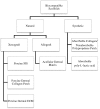Evaluating strategies and outcomes following rotator cuff tears
- PMID: 31019557
- PMCID: PMC6463377
- DOI: 10.1177/1758573218768099
Evaluating strategies and outcomes following rotator cuff tears
Abstract
Introduction: Rotator cuff tear surgical repair techniques have significantly progressed. However, tendon retear following primary repair persistently occurs at high rates. Rehabilitation protocols, surgical fixation techniques, biologic therapy with scaffolds, platelet-rich plasma, and even stem cell applications are under study to promote adequate tendon healing.
Methods: A nonsystematic query of the PubMed database was conducted in July 2016 utilizing the search terms "rotator cuff repair," "tear," "rehabilitation," "scaffold," "platelet-rich plasma," and "stem cell" to identify, analyze, and summarize relevant studies.
Conclusion: Individualized rehabilitation protocols may be the best approach for small to medium sized tears. Surgical fixation will continue to be debated as modifications to single-row technique and increases in suture number have improved tensile strength. Double-row repairs have been associated with higher costs. Transosseous equivalent technique exhibits comparable subjective and objective outcomes to single- and double-row repair at two-year follow-up. Biocompatible scaffold augmentation has showed inconsistent short-term results. Platelet-rich plasma has lacked uniformity in treatment preparation, administration, and outcome measurement with mixed results. Few human studies have suggested decreased retear rates and improved repair maintenance following bone marrow-derived mesenchymal stem cell augmentation. This review reiterated the necessity of additional high-quality, large-sample studies to develop any final verdict regarding efficacy.
Keywords: platelet-rich plasma; rehabilitation; rotator cuff repair; rotator cuff tear; scaffold; stem cell.
Figures
Similar articles
-
Arthroscopic Rotator Cuff Repair: A Systematic Review of Overlapping Meta-Analyses.JBJS Rev. 2019 Apr;7(4):e1. doi: 10.2106/JBJS.RVW.18.00027. JBJS Rev. 2019. PMID: 30939497
-
Ultrasound evaluation of arthroscopic full-thickness supraspinatus rotator cuff repair: single-row versus double-row suture bridge (transosseous equivalent) fixation. Results of a prospective, randomized study.J Shoulder Elbow Surg. 2013 Nov;22(11):1480-7. doi: 10.1016/j.jse.2013.06.020. Epub 2013 Sep 4. J Shoulder Elbow Surg. 2013. PMID: 24012360 Clinical Trial.
-
Clinical Outcomes of Modified Mason-Allen Single-Row Repair for Bursal-Sided Partial-Thickness Rotator Cuff Tears: Comparison With the Double-Row Suture-Bridge Technique.Am J Sports Med. 2015 Aug;43(8):1976-82. doi: 10.1177/0363546515587718. Epub 2015 Jun 8. Am J Sports Med. 2015. PMID: 26055919
-
Triple-Loaded Single-Row Versus Suture-Bridge Double-Row Rotator Cuff Tendon Repair With Platelet-Rich Plasma Fibrin Membrane: A Randomized Controlled Trial.Arthroscopy. 2016 May;32(5):753-61. doi: 10.1016/j.arthro.2015.11.020. Epub 2016 Jan 25. Arthroscopy. 2016. PMID: 26821959 Clinical Trial.
-
Platelet-Rich Plasma Reduces Retear Rates After Arthroscopic Repair of Small- and Medium-Sized Rotator Cuff Tears but Is Not Cost-Effective.Am J Sports Med. 2015 Dec;43(12):3071-6. doi: 10.1177/0363546515572777. Epub 2015 Mar 12. Am J Sports Med. 2015. PMID: 25767267 Review.
Cited by
-
Assessment of abduction motion in patients with rotator cuff tears: an analysis based on inertial sensors.BMC Musculoskelet Disord. 2019 Dec 12;20(1):597. doi: 10.1186/s12891-019-2987-0. BMC Musculoskelet Disord. 2019. PMID: 31830985 Free PMC article.
-
Mesenchymal Stem Cells From a Hypoxic Culture Can Improve Rotator Cuff Tear Repair.Cell Transplant. 2022 Jan-Dec;31:9636897221089633. doi: 10.1177/09636897221089633. Cell Transplant. 2022. PMID: 35438571 Free PMC article.
-
Reverse Shoulder Arthroplasty: Evaluation of the Clinical and Functional Outcomes per Etiology.Rev Bras Ortop (Sao Paulo). 2022 Jan 20;57(5):868-875. doi: 10.1055/s-0041-1731674. eCollection 2022 Oct. Rev Bras Ortop (Sao Paulo). 2022. PMID: 36226219 Free PMC article.
-
A Narrative Review on the Double Pulley-Triple Row Technique for Large to Massive Rotator Cuff Repair.Clin Orthop Surg. 2025 Jun;17(3):359-371. doi: 10.4055/cios24424. Epub 2025 May 15. Clin Orthop Surg. 2025. PMID: 40454127 Free PMC article. Review.
-
The role of scapular dyskinesis on rotator cuff tears: a narrative review of the current knowledge.EFORT Open Rev. 2021 Oct 19;6(10):932-940. doi: 10.1302/2058-5241.6.210043. eCollection 2021 Oct. EFORT Open Rev. 2021. PMID: 34760292 Free PMC article. Review.
References
-
- Oh LS, Wolf BR, Hall MP, et al. Indications for rotator cuff repair: a systematic review. Clin Orthop 2007; 455: 52–63. - PubMed
-
- Yamamoto A, Takagishi K, Osawa T, et al. Prevalence and risk factors of a rotator cuff tear in the general population. J Shoulder Elbow Surg 2010; 19: 116–120. - PubMed
-
- Osborne JD, Gowda AL, Wiater B, et al. Rotator cuff rehabilitation: current theories and practice. Phys Sportsmed 2016; 44: 85–92. - PubMed
-
- McElvany MD, McGoldrick E, Gee AO, et al. Rotator cuff repair published evidence on factors associated with repair integrity and clinical outcome. Am J Sports Med 2015; 43: 491–500. - PubMed
Publication types
LinkOut - more resources
Full Text Sources

